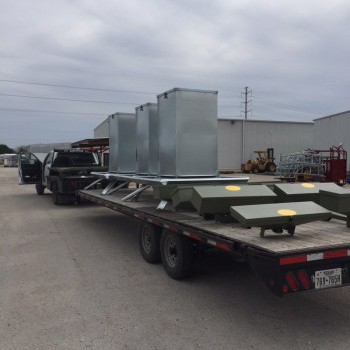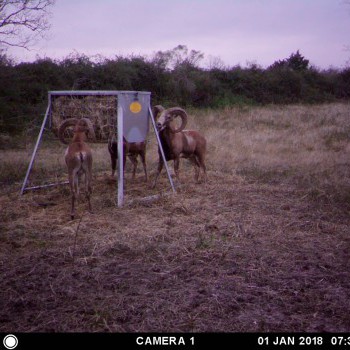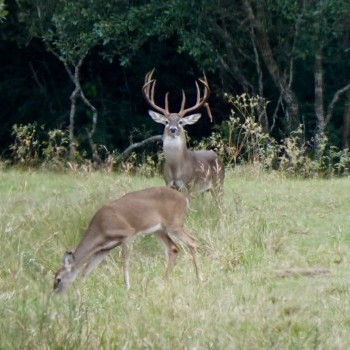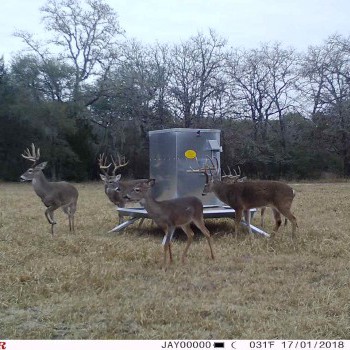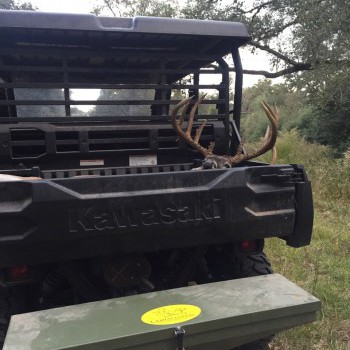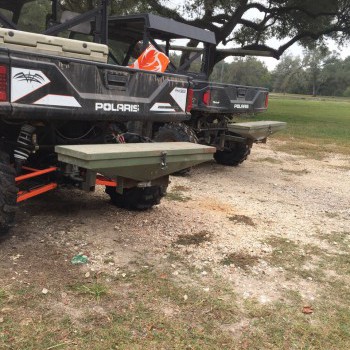Food Plots for White-tailed Deer
Original article: https://agrilifecdn.tamu.edu/wildlife/files/2010/05/Food-Plots-for-Deer.pdf
By Texas A&M ArgiLife
Reasons for Planting Food Plots
Planting food plots is one of the most widely used wildlife habitat improvement techniques. The major reasons for planting deer food plots include: (1) using plots as a lease marketing strategy, (2) increasing viewing and photographing opportunities, and (3) increasing the nutritional quality and quantity of available forage.
Presence of food plots often represents the landowner’s commitment to deer management, which can aid the landowner in marketing lease property to prospective hunters. Billy Higganbotham, Texas A&M Wildlife Extension Specialist, estimated that for each 1% of the land base planted in food plots, the value of a hunting lease could be increased from $0.80 to $1.20 per acre.
A second reason to plant food plots is to make deer more visible for viewing or photography. Many landowners, managers, and hunters derive satisfaction from observing deer. Increased visibility also may benefit landowners involved in ecotourism, which is a growing industry. Additionally, high visibility of deer feeding in food plots can aid managers in monitoring the body condition of deer, progress in antler growth, and other biological factors.
The third objective of planting food plots is to increase the quality and amount of forage available to deer. Researchers in Mississippi found that maintaining 0.5% of an area in year-round agronomic food plots increased body mass, number of antler points, beam circumferences, and beam lengths of white-tailed deer. In Louisiana, yearling male whitetailed deer exhibited a 19% increase in live weights following establishment of cool-season food plots.
Much interest exists among landowners in improving antler size of white-tailed deer. Genetic improvement of deer has received considerable popular interest, but nutrition is more important in free-ranging deer. Good nutrition is essential to produce large-bodied and large-antlered deer. Improving genetics through culling of “inferior” animals or introducing superior “breed bucks” will have little impact on free-ranging white-tailed deer populations on a practical time scale. Even if genetic improvement did impact free-ranging deer, habitat that provides high levels of nutrition is needed for deer to express their genetic potential.
Unfortunately, nature does not consistently supply an optimally nutritious diet to deer. Nutritional quality and availability of forbs (broad-leaved weeds) and browse (shrub leaves and twigs) fluctuate seasonally, limiting availability of natural foods at certain times of the year.
Deer prefer forbs over browse and generally consume little grass except when it is young, green, and succulent. During rainy winters and springs, forbs often are abundant, resulting in deer that are on a high nutritional plane. Most forbs grow best during cooler periods and their abundance declinesby May or June. Availability of forbs is limited during summer. Thus, late summer is often a period of nutritional stress for deer in the southeastern United States. Rains generally occur in late September and October in Texas. These rains stimulate plant growth and improve the nutritional quality of deer diets during the fall. As with other times of the year, rainfall in September and October is sometimes lacking, resulting in poor forage conditions.
Although winter forbs are abundant if rainfall is adequate, dry winters result in a lack of green, nutritious forbs. Such winters may result in nutritional stress for deer, particularly if a hard freeze occurs. Franz Vogt found that red deer stags had to be in a good nutritional state at least one month before antler growth began to grow antlers of maximum size. If this is true for white-tailed deer in south Texas, then February to May could be a particularly critical time to have high-quality forage available since the period of maximum antler growth for bucks is mid-June through mid-August.
An abundance of forbs and preferred browse species is critical to maintain deer on a high nutritional plane. Both forbs and browse decline in nutritional quality during summer, particularly when rainfall is low. When forbs are lacking, browse becomes the mainstay of deer diets. Researchers at Texas A&M University-Kingsville and the Caesar Kleberg Wildlife Research Institute discovered that the energy content of natural deer foods drops below levels required for maintenance during July and August. In addition, protein levels drop below the optimum for body growth. This deficiency can cause weight loss or reduced weight gain and may result in reduced antler growth. Fawns are born during summer in south Texas and if the high nutrient demands of lactating does are not met, fawn survival will be reduced. Detrimental impacts on deer are accentuated if poor forage conditions are prolonged by drought or if the habitat has been overgrazed by livestock or wildlife.
Role of Food Plots in Deer Management
Food plots should be just a part of an overall management program in which the top priority is maintaining high quality native habitat. Proper management is accomplished by maintaining deer densities within the carrying capacity of the habitat, avoiding overgrazing by livestock, and application of habitat improvement practices such as prescribed burning. For trophy deer management, sex ratios should be maintained near 1:1 and only mature bucks (5 1/2+ years old) should be harvested. The effect of food plots or any form of supplemental feeding on nutritional status, productivity, and quality of a deer herd will be reduced if one or more of the aforementioned management priorities are ignored. Only when these priorities are accomplished should consideration be given to establishing food plots. Food plots and supplemental feeding are not substitutes for proper population and habitat management.
Many people who promote supplemental feeding(pelleted feeds and food plots) advocate it as a tool to increase deer densities beyond the carrying capacity of the habitat. Maintaining high deer densities at levels that threaten to degrade the habitat is dangerous, particularly in semiarid areas. Native forages comprise a significant portion of deer diets regardless of how much supplement is provided. High deer densities may be maintained in years with normal or above-average rainfall, but sooner or later a drought will occur. Too many deer in a droughtstressed habitat will result in degraded habitat, reducing the ability of the habitat to produce quality bucks in the future. So, keep supplemental feeding as just that—a supplement, not the main course.
BASICS OF GROWING FOOD PLOTS
What to Plant
Cool-season food plots planted with mixtures of grasses that include oats, wheat, and triticale and legumes such as hairy vetch, Austrian winter peas, alfalfa, and hubam clover provide nutritious forage from November through April or May. Planting wheat alone had little impact on white-tailed deer diet quality during February in a recent study conducted by one of my students. Planting mixtures that include nutritious legumes is recommended. Warm-season food plots should provide forage from early spring until late fall and supplement natural vegetation during July-August when natural forages are lacking in quantity and quality. Plants adapted to hot, dry conditions, and intensive farming are essential for producing forage during summer in semiarid areas.
Moisture management techniques used in dryland farming such as deep tillage and weed control are necessary for producing food plots in semiarid areas. For warm-season crops such as lablab or cowpeas, plots should be deep tilled in late summer to store rainfall during September and October. Light cultivation or herbicides should be used following rainfall events during the winter to maintain a weedfree seedbed. Weeds should be eliminated since they use the stored soil moisture that will be needed in the spring to support growth of food plot forages.
Use of pre-emergence (pre-planting) herbicides and periodic cultivation between planted rows until the crop is too large to cultivate will maximize the survival and production of food plot forages.
Perennial Versus Annual Food Plots
Seeds of several perennial native plant species including Maximillian sunflower, Engelmann daisy, bush sunflower, and Illinois bundleflower are commerciallyavailable for planting. Perennial
food plots appeal to wildlife managers since they provide permanent vegetative cover and do not have to be replanted every year. Steve Nelle, from the Natural Resources Conservation Service, reported that in central Texas (20 to 25 inch rainfall zone) various mixtures of these plant species can produce 3,000 pounds of forage per acre. Nelle also noted that establishment of perennial food plots is expensive (ranging up to $100 per acre just for seed) and the plots are management-intensive, which further increases costs.
Generally, perennial food plots produce less forage for deer than annual food plots. One factor is soil compaction that results from concentrations of deer in perennial plots; during rainfall events, the compacted soil facilitates runoff, which results in decreased water infiltration and less water for plants.
Also, many commercially-available perennials such as bush sunflower have very small seeds that require planting at shallow depths. Consequently, these plants often are difficult to establish in semiarid areas because soil moisture is seldom adequate to support seed germination or seedling growth at shallow planting depths.
Fencing Food Plots
All food plots, whether warm-season or coolseason, should be fenced to prevent livestock from grazing them. Additionally, warm-season annual
plots should be fenced from deer. Emerging seedlings of lablab and many other warm-season species are easily killed by grazing deer. Resistance to grazing greatly increases once the plants are about four or five weeks old. It makes little sense to spend money planting a food plot only to have it grazed out before the plants are large enough to provide an appreciable amount of forage.
There are two ways to avoid the problem of “graze out.” One is to plant very large food plots (greater than 50 acres). The second is to surround the food plot with a fence that can be manipulated to allow deer access to the plots once the plants are large enough to withstand grazing. A number of conventional and electric fence designs have been developed to temporarily exclude deer from plots.
Number and Size of Food Plots
Based on research that my students and I conducted in south Texas, I recommend establishing at least one warm-season and one cool-season food plot per square mile, as soils permit. A lablab field that produces 3,000 pounds of forage per acre will support 2.5 adult white-tailed deer per acre for six months. This calculation is based on an average consumption of 5.5 pounds of dry matter per day with lablab averaging 60% of the dry matter consumed. Also, it assumes 50% use of the forage because the leaves are the most nutritious and palatable portion of the plant. If we assume that warm-season food plots will support 2.5 white-tailed deer per acre for six months, then acres of food plot needed can be determined if the density of deer per square mile is known. For a warm-season food plot with a density of 35 adult deer per square mile:
acres needed = No. deer per square mile ÷ 2.5 deer per acre
= 35 deer per square mile ÷ 2.5 deer per acre
= 14 acres per square mile
Thus, for a density of 35 adult deer per square mile, warm-season food plots within each square mile should be at least 14 acres.
Selecting Proper Soils
Clearly, the most fertile and productive soils produce the highest yielding food plots. However, these soils usually support the best native habitat. When possible, food plots should be established on sites where the native habitat has previously been degraded. Converting good quality native habitat into food plots is not a wise management decision.
Typically, ranches are in areas where soils are not conducive to producing agricultural crops. Soils often are too saline, rocky, or sandy for cultivation. To find which soil types are capable of producing crops and where these soils are located on your ranch or lease, contact your local USDA Natural Resources Conservation Service Office. For most counties, the Natural Resources Conservation Service has published soil surveys that contain information on the suitability of particular soils for growing crops and the value of the soils for wildlife habitat.
Shape of Food Plots
Biologists often recommend planting long, narrow food plots to maximize “edge effect.” A cotton field growing beside a mesquite pasture will clearly illustrate why this idea does not work in drier areas. Cotton plants nearest to the mesquites are small and stunted in comparison with plants in the middle of the field. This is because the mesquites compete with the cotton plants for soil water. Food plots in a long, narrow plot bordered on either side by brush is analogous to trying to produce a cotton crop by planting only the edge of the field next to a mesquite pasture. The result will be a sparse stand of stunted plants in years that rainfall is average or below average. For best results, food plots should be square-shaped. If rectangular plots are used, they should be as wide as possible.
Food Plots and Cover
Scattered clusters of brush often are left in food plots to provide security cover. Deer tend to bed in the brush clumps and feed around them. Although brush clumps are intuitively a good idea, they reduce forage production for many yards around the clump for reasons previously discussed about water competition. Furthermore, the brush clumps make it more difficult to maneuver a tractor around in the food plot when planting and cultivating. Both of these problems counterbalance the additional security provided by the brush. Deer will forage in the middle of rectangular 15-acre food plots whether or not brush clumps are present once forage at the edges of plots has been grazed out.
Inoculating Legumes
One of the values of growing legumes is that they form a relationship with certain bacteria which live in association with the plant roots. These bacteria take nitrogen from the air and release it in a form that plants can use. The inoculant that is sold with legumes such as lablab, soybeans, cowpeas, and clovers contains nitrogen “fixing” bacteria and ground up peat moss. The peat moss containing the bacteria is mixed with the seeds before planting. Once the seedling emerges, the bacteria form growths on plant roots called nodules. Presence of these nodules indicates that the bacteria are alive and producing nitrogen.
Inoculant should be stored in a refrigerator because the bacteria can die when exposed to excessively warm temperatures or when the peat moss dries out. Fertilizing the soil before or after planting with nitrogen may reduce nodulation. Thus, when planting legumes, fertilizers low in nitrogen and high in phosphorus should be used.
Mixing inoculant with seeds to ensure proper seed coverage is essential. To aid in making the inoculant stick to the seeds, many people use commercial tackifiers or liquids such as soda pop, pet milk, or other sticky substances. Inoculation may not be needed in plots where the same plant species have been planted for several years with inoculated seeds because the soil contains sufficient bacteria from the previous plantings.
SKIP ROW PLANTING FOR DRY AREAS
Effects on Plant Survival
Cotton farmers in semiarid areas often leave unplanted rows between pairs of planted rows to increase availability of moisture to the crop. My students and I conducted a study in an area that averages 18 inches of annual rainfall to determine if “skip-row” planting would increase survival of lablab plants during the late summer.
The amount of lablab produced was similar among planting designs during May through July. However, in August many of the plants in plots where every row was planted died, whereas few plants died in plots where skip row planting was used. Consequently, more food was available during August in skip row plots. The magnitude of the difference between plots depended on rainfall. For example, in August 1994 (an average rainfall year), skip-tworow plots had 32% more forage than plots with every row planted. In 1995, with rainfall 13% below the
long-term average, plots planted with two skip rows between pairs of planted rows contained 13 times more forage during August than plots with every row planted. Another advantage of skipping two rows between pairs of planted rows is that seed costs are reduced by 50%.
Effects on Deer Feeding Behavior
Deer appear to feed only along the edges of lablab food plots when planted with 3-foot row spacing. My graduate student, Jeff Bonner, tested the idea that by leaving unplanted rows between pairs of planted rows, deer would feed into the middle of plots. We envisioned that the unplanted rows would serve as travel lanes into the plots. In some plots, every row in 3-foot rows was planted; in some plots, a row between pairs of planted rows was skipped; and, in some plots two rows were skipped between pairs of planted rows. printed on recycled paper
Observations revealed that deer ate mainly along the edges of the food plots until the forage at the plot edge had been consumed, regardless of whether the plot was planted in skip rows or not. Once most of the forage was eaten at the edges, deer began feeding further into the plots until forage in that portion of the plot was consumed. Thus, our results indicated that deer will feed in the middle of the plots when forage in other parts of the plot is depleted.

